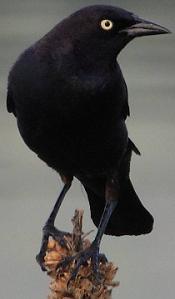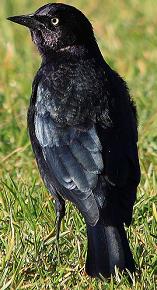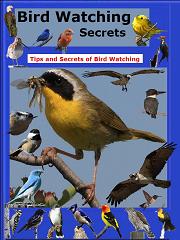Brewer's Blackbird 
Identification and Pictures
(Euphagus cyanocephalus)
Brewer's blackbirds; name after ornithologist Thomas Mayo Brewer,
are all black with yellowish eyes, about 8 to 10 inches. They have a
pointed bill, long legs, and a long tail. In strong sun light they have iridescent,
purplish reflections on the head, and neck, and metallic green on the
body. In the winter they may have rusty barring. The females are
brownish gray with a dark eye. They are often mistaken for European starlings,
which have a much shorter tail.
Photos by Keith Lee.
The camera I use is the Canon
EOS 40D. Visit All-birds store
Songs and calls
The song is a harsh que-ee sound, like a
rusty hinge. They also have a sharp check call.
sound
Range and Habitat
 Brewers
range across much of North America, rare in the
east. Birds in the west may stay year round, but
those in the north will fly south for the winter.
They may be found in a large variety of habitats such as
prairies, open fields, woodlands, marshes, and
towns. They have adapted well to humans, and may be
seen in farm lands, parks, golf courses, lawns, and
parking lots. Brewers
range across much of North America, rare in the
east. Birds in the west may stay year round, but
those in the north will fly south for the winter.
They may be found in a large variety of habitats such as
prairies, open fields, woodlands, marshes, and
towns. They have adapted well to humans, and may be
seen in farm lands, parks, golf courses, lawns, and
parking lots.
Breeding and Nesting
They are very social birds that nest in
loose colonies of up to a hundred birds. The males
will guard colonies from perches. If predators
such as hawks are spotted they will give an alarm call,
and often dive at them to make them leave. The
first females to arrive in the nesting area will choose
their nest sites, and others will find sites around
them. The nest is built of twigs, course grass,
and mud, and lined with fine grass, and hair. It
may be on the ground, in a bush, or in a tree. The
female will lay 4 to 6 heavily spotted eggs, which will
vary in color and pattern. She will incubate them
for 12 to 14 days.
Food and Feeding
Natural foods are seeds, grains,
insects, spiders, and fruits. Most foraging is on
the ground, but they will all catch insects in the
air. When foraging on the ground, they may flip
over stones to look for insects. They do some damage to
fruit in orchards, but they make up for this by eating a
large amount of harmful insects.
To learn about other
favorite birds click here.

|
|
|
 All-birds Store
All-birds Store
Bird Watching guides, books, binoculars,
cameras, gifts for bird lovers, bird baths, feeders
and more... baths, feeders
and more...
|
|
|
RECOMMENDED READING
Available for Immediate
Download

Click
here
|
|
